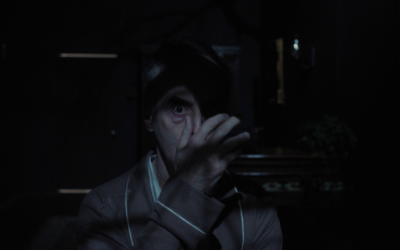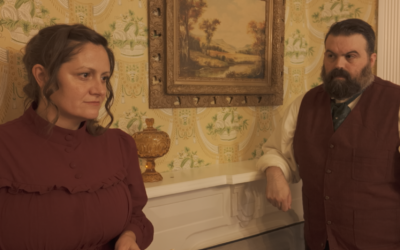
In this world, many people feel the need to conceal their true feelings behind the veneer of a brave face or a saccharin smile to hide what they truly feel deep down. Such is the case for Geoffrey Oswald Dodd, a mild mannered high school teacher. At first glance he seems like a fairly amiable gent, but deep inside he is filled with venom and vitriol for his students and colleagues.
He goes about his day, observing the same old humdrum routine. But little do those around him know of the malice, anger, frustration and resentment that are festering beneath the surface. Everyone has varying levels of tolerance in regard to reaching ones breaking point…has Mr. Dodd finally reached and breached his?
Worm was directed by Richard Powell, from a script he also penned. It’s a disturbing look behind the curtain of one man’s warped psyche. What I really liked about this story is that it’s primarily driven by the main character’s internal monologue. The audience bears witness to the ugliest and most vile thoughts of one man toward his students and fellow staff members, even though the words never cross his lips. It’s even more disconcerting, because of the pleasant and genial shell he hides behind.
This film presents an opportunity for the audience to go inside a man’s head and get to know exactly what he’s thinking, because we have all at one time or another wondered that about someone. It also creates a reasonable expectation that this man might not only be approaching his boiling point, but that we all may have the proverbial “ringside seat” to witness the moment when he snaps…maybe. A potential antagonist lingers in plain sight, and absolutely nobody on screen is privy to it…but we are, and that’s chilling.
The cast of Worm did a great job, but it’s no secret that the focus here is on Robert Nolan. So much of his role depended on his voice over – the tone and the inflections. Suffice to say he absolutely nailed it. His facial expressions and other non verbal cues were essential to successfully conveying his innermost feelings and emotions. Some required overt responses while others needed to be properly subtle. Again, Nolan is able to deftly execute this nonverbal portion of his character portrayal. But as I said before, his supporting cast rose to the occasion giving him the proper stimuli for him to react to.
The cinematographer was another aspect that aided in the film’s overall sense of tension. Brendan Uegama’s shot composition, framing and camera movement were of great benefit to the film’s look. Particularly, the use of closeups aided in creating an uneasy feeling for the viewer.
Worm was released in 2010 and is the first film in what has become known as The Boxcutter Trilogy. All three films in the trilogy were created by the gifted writer/director, Richard Powell. The trilogy also features the very talented Robert Nolan in each film. This particular film gives the audience an opportunity to see that being privy to someones innermost thoughts and feelings may end up being more twisted and disturbing than hey could ever have fathomed. So remember this my Little Monsters, just because somebody is smiling doesn’t mean they aren’t thinking sinister thoughts. For some people, that is their happy place. 8 / 10
Spoiler-Free Review: The Haunted Season: The Occupant of the Room
Official Synopsis From renowned author and filmmaker Kier-La Janisse (Woodlands Dark and Days Bewitched: A History of...













